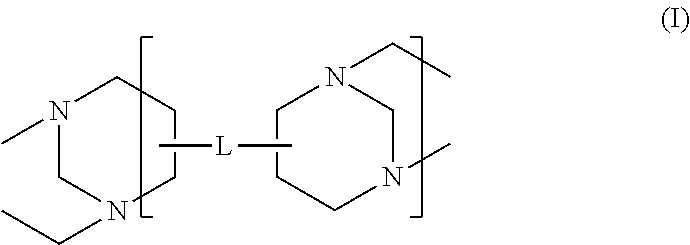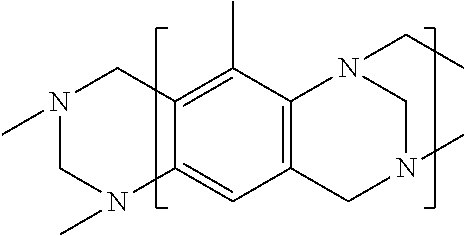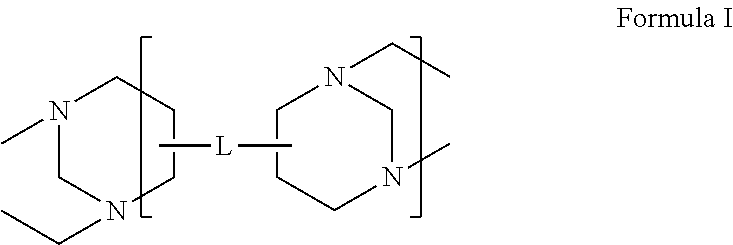Troger's base polymers having intrinsic microporosity
a polymer and microporosity technology, applied in the field of polymer having intrinsic microporosity, can solve the problems of nanoporosity and polymer stability, and achieve the effects of superior stability, novel solubility characteristics, and unique reactivity
- Summary
- Abstract
- Description
- Claims
- Application Information
AI Technical Summary
Benefits of technology
Problems solved by technology
Method used
Image
Examples
example 1
Condensation of 3,5-diaminobenzoic Acid Dihydrochloride, with Dimethoxymethane in Trifluoroacetic Acid as Represented in Reaction Pathway II
[0116]Reaction Stoichiometry: 1) 3,5-Diaminobenzoic acid dihydrochloride, 99%, 1.50 grams used (6.665 millimole). 2) Dimethoxymethane, 99.9% actual GC purity on COA, 2.03 grams used (26.658 millimole). 3) Trifluoroacetic acid (TFA), 99%, 99.8% actual GC purity on COA, 20 milliliters used.
[0117]3,5-Diaminobenzoic acid dihydrochloride was weighed under dry nitrogen into a 2 ounce glass bottle containing a magnetic stirring bar and TFA was added. The bottle was sealed and magnetically stirred to give a light amber colored solution and thereafter dimethoxymethane was added, the bottle resealed with continued stirring until a bright yellow colored slurry initially formed. After 67.5 hours, the slurry was transferred to a 500 milliliter glass beaker along with 200 milliliters of DI water with continued stirring and pH adjustment from 1 with dilute 5% ...
example 2
Condensation of 3,5-Diaminobenzoic Acid Dihydrochloride, with Paraformaldehyde in Trifluoroacetic Acid as Represented in Reaction Pathway I
[0121]Reaction Stoichiometry: 1) 3,5-diaminobenzoic acid dihydrochloride, 99%, 1.50 grams used (6.665 millimole). 2) Paraformaldehyde, ≥88%, 0.80 gram used (26.658 millimole). 3) Trifluoroacetic acid (TFA), 99.8% actual GC purity on COA, 20 milliliters used. 3,5-Diaminobenzoic acid dihydrochloride and paraformaldehyde were weighed under dry nitrogen into a 2 ounce glass bottle along with a magnetic stirring bar and TFA was added with magnetic stirring. The bottle was sealed and magnetically stirred to give a yellow colored slurry. After 67 hours, the slurry was transferred to a 500 milliliter glass beaker along with 200 milliliters of DI water with continued stirring and pH adjustment from 1 with dilute 5% weight sodium hydroxide solution to 7. At pH 7, the bright orange powder went into solution with only a slight haziness. The pH was then adjus...
example 3
Condensation of 2,4-diaminophenol Dihydrochloride with Dimethoxymethane in Trifluoroacetic Acid as Represented in Reaction Pathway VI
[0125]Reaction Stoichiometry: 1) 2,4-Diaminophenol dihydrochloride, 98%, 1.50 grams used (7.612 millimole). 2) Dimethoxymethane, 99.9% actual GC purity on COA, 2.32 grams used (30.45 millimole). 3) Trifluoroacetic acid (TFA), 99.8% actual GC purity on COA, 20 milliliters used.
[0126]2,4-diaminophenol dihydrochloride was weighed under dry nitrogen into a 2 ounce glass bottle containing a magnetic stirring bar and TFA was added. The bottle was sealed and magnetically stirred to give a gray colored slurry and thereafter dimethoxymethane was added, the bottle resealed with continued stirring until a hazy dark amber colored solution formed. After 67.5 hours, the hazy solution was transferred to a 500 milliliter glass beaker along with 200 milliliters of DI water with continued stirring and pH adjustment from 1 with dilute 5% weight sodium hydroxide solution ...
PUM
| Property | Measurement | Unit |
|---|---|---|
| pore diameters | aaaaa | aaaaa |
| diameter | aaaaa | aaaaa |
| thickness | aaaaa | aaaaa |
Abstract
Description
Claims
Application Information
 Login to View More
Login to View More - R&D
- Intellectual Property
- Life Sciences
- Materials
- Tech Scout
- Unparalleled Data Quality
- Higher Quality Content
- 60% Fewer Hallucinations
Browse by: Latest US Patents, China's latest patents, Technical Efficacy Thesaurus, Application Domain, Technology Topic, Popular Technical Reports.
© 2025 PatSnap. All rights reserved.Legal|Privacy policy|Modern Slavery Act Transparency Statement|Sitemap|About US| Contact US: help@patsnap.com



